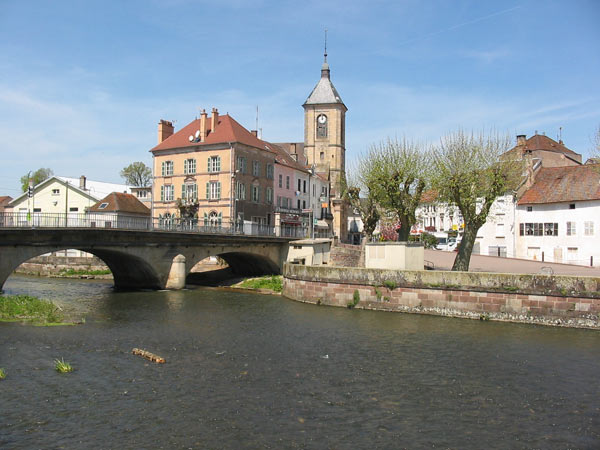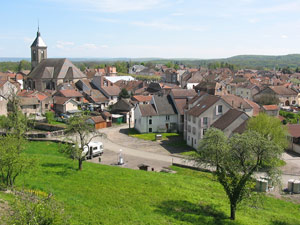Saint-Loup-sur-Semouse
Saint -Loup- sur- Semouse is a commune in Haute -Saône in the Franche -Comté. It is the capital of the canton of Saint -Loup- sur- Semouse in the arrondissement of Lure.
Geography
Saint -Loup- sur- Semouse situated at an altitude of 244 m above sea level, 11 km northwest of Luxeuil -les- Bains and about 31 km north- northeast of the town of Vesoul (air line). The village extends to the north of the department, in the western part of the plain of Saint -Loup- sur- Semouse, at the Semouse, at the edge of the heights of Voge.
The area of 16.54 km ² municipal area includes a portion of the plain of Saint -Loup- sur- Semouse. From northeast to southwest, the area is crossed by the Alluvialniederung the Semouse that provides drainage for Lanterne. The valley is on average 245 m and has a width of up to three kilometers wide. In the area of Saint -Loup- sur- Semouse the Semouse increases from left to Augronne and north of the Ruisseau du Chanet on. Because of the high ground water level former sand and gravel pits are filled with water.
On the northern side of the valley is flanked hills that partly forested, are passed partly under arable and meadow land. In the north are the hills of the Bois du Plein Chanoi, in the west of Mont Amarin (up to 300 m) and the Bois de Laboncourt (293 m). To the south, the municipality's area of the plain and the lowlands of running parallel to the Semouse Combeauté to the adjacent forest heights of the Bois du Griselier extends. With 315 m find the highest mountains of Saint -Loup- sur- Semouse is achieved.
The ups consist mainly of limestone north of Semouse the Middle Triassic geological- tectonic In regard. The surveys south of the alluvial plain are composed of a alternation of calcareous and sandy- marly sediments that were deposited during the Lias ( Lower Jurassic ).
At Saint -Loup- sur- Semouse include the settlements Le Chanois (246 m) on the southern edge of the Talniederung and Augrogne (242 m) in the valley of Semouse. Neighboring municipalities of Saint -Loup- sur- Semouse are Aillevillers -et- Lyaumont, Fleurey -lès -Saint -Loup and Magnoncourt in the north, Corbenay and Fontaine- lès- Luxeuil in the east, Hautevelle, Francalmont and Ainvelle in the south and La Pisseure, Anjeux and Bouligney in the West.
History
The municipality of Saint -Loup- sur- Semouse was settled in late antiquity. Here was the settlement Grannum. In 451, the town was attacked and destroyed by the Huns. St. Lupus, bishop of Troyes, is opposed Attila the Hun. To him, the town was henceforth known as Saint- Loup honor.
In the Middle Ages, Saint- Loup became a borough. In 1276, here the Hospital Saint -Nicolas was established, which existed until 1785. Saint- Loup was controversial for a long time between the Dukes of Burgundy and Bar. 1475 and 1477 it was occupied temporarily by forces under Charles the Bold. Saint- Loup initially did not get along with the Franche -Comté with the Peace of Nijmegen in 1678 to France. The French king Louis XIV annexed it to the place in 1679, which was approved only with the Treaty of Besançon ( 1704).
During the 18th century, Saint -Loup- sur- Semouse developed thanks to the abundant water power to an industrial and business center with mills, iron and forging plants, wood processing, tanneries and textile industries. Another big growth there was in 1860 with the establishment of a chair factory under François Lebrun. Thus, the foundation was laid for the furniture industry, giving the town earned the name Cité du Meuble (furniture city). With the opening of the railway line from Faverney after Aillevillers Saint -Loup- sur- Semouse was tied in the second half of the 19th century to the French railway network. Today Saint -Loup- sur- Semouse is the administrative seat of the comprehensive 12 villages municipal association Communauté de communes du Val de Semouse.
Attractions
The church of Saint -Loup- sur- Semouse was inaugurated on 13 December 1789. For remarkable Interior features include a marble altar from the 16th century, a painted statue of the Madonna from the 14th century as well as paintings and other statues from the 17th and 18th centuries. The Château de Maillard, also called Château des Bouly, was built in 1775 at the instigation of the master blacksmith Jean- Baptiste Bouly and is now classified as a monument historique. About the Semouse performs a stone bridge dating from the 18th century.
Population
With 3353 inhabitants ( 1 January 2011) Saint -Loup- sur- Semouse one of the largest municipalities in the department of Haute- Saône. After the population had decreased in the first half of the 20th century, first (1901 3709 people were counted ) from 1954 to 1982, a continuous population growth was recorded. During this period, the population had almost doubled. At the beginning of the 80s, the previous high was reached with just over 4900 inhabitants. Because of the crises of the industries that are based in Saint -Loup- sur- Semouse, since a significant population decline has been registered. The decline since 1982 was around 25%.
Economy and infrastructure
Saint -Loup- sur- Semouse made early on by the development of a marked industrial and commercial location. Larger industrial and commercial zones are located on the eastern outskirts of the village. The most important industry is still the furniture manufacturing, where the span of the production from handicraft to contemporary furniture ranges. Saint -Loup- sur- Semouse is the seat of Groupe Parisot ( about 800 jobs ). Other industries include the packaging industry, the construction of agricultural machinery, construction, the textile industry and precision engineering. In addition, owns Saint -Loup- sur- Semouse as a regional center numerous businesses of retail, a supermarket and the service company for your daily needs. It is the site of the Collège.
The village has good transport links. It lies on the old main road that leads from Luxeuil -les- Bains to Bourbonne -les -Bains. By -pass road of the village is relieved of through traffic. Further road links exist with Bains- les- Bains, Corbenay and Conflans -sur- Lanterne.
Partnerships
Saint -Loup- sur- Semouse maintains a partnership with the community foot castle in the German state of Baden- Württemberg.
Personalities
- Armand Petitjean, French businessman and perfumer










